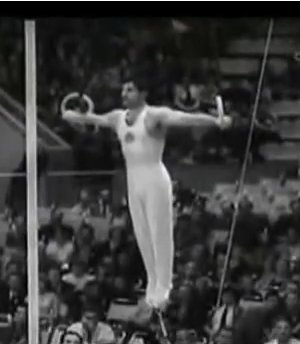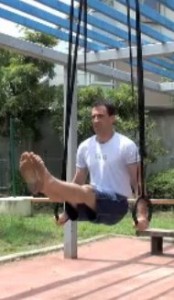
Albert Azaryan, the lord of the rings.
I know what it is like to want a pair of gymnastic rings. Have I acquired this knowledge by mere imagination, by simulating in my own mind what it might be like to want them, like an author might for his literary fiction? Like Dostoevsky, imagining the plagues of guilt and fear which swept into the mind of his first-time murderer for Crime and Punishment, his acclaimed work of psychological fiction, all without ever actually staining his own hands in the blood of another man? No, this is not just a guess, a work of fiction; I write about what I know: I have actually wanted rings before, gymnastic rings for “Elite-Fitness”. I have felt the empty longing in my chest, I have envisioned the dangling circles, swaying gently, recovering their stillness after a set of strenuous dips. But always between that clear vision and reality their existed a fog of ignorance and questions: how much do they cost? what type should I buy? what sort of straps and buckles do I need?
There are some who allow this fog to forever divide actuality from their dreams, but I am not one of them. Nor are you. You are searching right now, and you have come to the correct page. The words and pictures on this page are a forceful breath of knowledge that will answer all your questions and will dispel your fog concerning rings, whether you are searching for a personal set to use at home or you are equipping a whole “Elite-Fitness” gym.
What to Want in Rings
The Straps and Buckle
The “Elite-Fitness” exercises which utilize rings are mainly dips, push-ups, pull-ups, and muscle-ups. If one is particularly elite hand-stands and hand-stand push-ups would be added to that list. What should be noted is that these exercises require the rings to be adjusted to three different heights: low for push-ups and hand-stands, medium for dips, and high for muscle-ups and pull-ups. Supposing that more than one person will use the rings, and that the heights of the users are different or unpredictable, then the middle range especially will also need to be adjusted between users. Distilling from these requirements the essence of what is needed in a pair of rings, we see that they should have straps that are long enough to reach to the ground and should be easy and quick to adjust. The straps should have some sort of marks indicating the distance of the rings from the support to assure that they are level and to help users recall their preferred positions. Needless to say, and said without need, the straps must be strong enough to support much more than the weight of their user without snapping.
The Rings
The rings themselves can be made of different materials and have varying weight. The weight is important only because when released the rings may return to club the user in the head, which may cause contusions and even bleeding on rare occasions. The material is also important because it determines the strength, feel, grip, and durability of the rings. Because they are so heavy, metal rings are considered slightly dangerous and are not often recommended, except for prolonged outdoor use. Plastic rings, depending on the type of plastic, can be very good in every category except that when sweat covers their surface they become slippery. Wooden rings are ideal because they absorb sweat and are inherently grippy, yet also strong and lightweight.
My Recommendations
I have found a set that have excellent straps and buckles with rings made of either plastic or wood, both made by Christian’s Fitness Factory, a well-known “Elite-Fitness” equipment supplier.
CFF Plastic Olympic Gymnastic Rings
The straps are numbered and marked every 3 inches so that it is easy to adjust the rings to the correct height. A heavy-duty cam buckle is used to secure the straps at the correct length. The buckle is the variety that releases by simply depressing one side, which releases the teeth from the strap, making adjustment as fast and simple as possible. Compared to S-straps, the cam buckles really save time and are much simpler. The strap and cam buckle are rated to hold 1000 lbs each. The straps are 18 feet long, which allows you to bring the rings to the floor, even from a tall ceiling.
The rings themselves are made of a high impact polycarbonate resin, which is the type of plastic used for hockey masks, compact discs, eye-glasses, bullet-proof glass, and auto parts. The rings are lightweight and strong, rated to support over 1000 lbs each.
The CFF Plastic Rings are extremely high quality, yet also very affordable, and will cost you only about $52 over at Amazon. Considering that the cheapest “real” rings you’ll find anywhere else are at least $40 and are of questionable quality, this is a great deal.
CFF Wood Olympic Gymnastic Rings
The wood rings kit from CFF has slightly wider straps and buckles that will each support over 1500 lbs. The straps are 18 feet long and contain height measurements at every 3 inches. The wood rings themselves have a natural wood finish which guarantees a consistent grip, even after the rings have been soaked with sweat. Wood rings are also lighter and stronger than plastic. These rings are rated to hold over 1000 lbs. They cost around $82, about $30 more than the plastic rings, which is why I recommend buying mostly plastic rings for your gym, but getting a few wooden pairs for muscle-ups or for home use.
Conclusion
I hope that by now you are completely confident about which rings to buy. It’s really a question of wood or plastic, which is decided by price and how much sweat your wrists generate. Don’t wait around too long thinking about buying rings, because the sooner you get them the sooner you will begin increasing your muscle mass, stretching and improving flexibility, and gaining great muscle balance.


Recent Comments